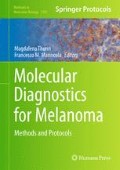Abstract
Intact miRNAs can be isolated from the circulation in significant quantities despite the presence of extremely high levels of RNase activity. The remarkable stability of circulating miRNAs makes them excellent candidates for biomarkers in diagnostic applications as well as therapeutic targets in a variety of disease states including melanoma. Circulating RNA molecules are resistant to degradation by RNases because they are encapsulated in membrane-bound microvesicles. We describe a convenient method for the use of ExoQuick, a proprietary resin developed by Systems Biosciences (Mountain View, CA), whereby microvesicles can be purified under gentle conditions using readily available laboratory equipment. This protocol allows for isolation all microvesicles, regardless of their origin, and provides a convenient method for identifying potential cancer-specific biomarkers from biological fluids including serum and plasma.
Access this chapter
Tax calculation will be finalised at checkout
Purchases are for personal use only
References
Bartel DP (2009) MicroRNAs: target recognition and regulatory functions. Cell 136:215–233
Bartel DP, Chen CZ (2004) Micromanagers of gene expression: the potentially widespread influence of metazoan microRNAs. Nat Rev Genet 5:396–400
Pillai RS (2005) MicroRNA function: multiple mechanisms for a tiny RNA? RNA 11:1753–1761
Bushati N, Cohen SM (2007) microRNA functions. Annu Rev Cell Dev Biol 23:175–205
Sayed D, Abdellatif M (2011) MicroRNAs in development and disease. Physiol Rev 91:827–887
Lee YS, Dutta A (2009) MicroRNAs in cancer. Annu Rev Pathol 4:199–227
Erson AE, Petty EM (2008) MicroRNAs in development and disease. Clin Genet 74:296–306
Ruan K, Fang X, Ouyang G (2009) MicroRNAs: novel regulators in the hallmarks of human cancer. Cancer Lett 285:116–126
Calin GA, Croce CM (2006) MicroRNA signatures in human cancers. Nat Rev Cancer 6:857–866
Iorio MV, Croce CM (2012) MicroRNA dysregulation in cancer: diagnostics, monitoring and therapeutics. A comprehensive review. EMBO Mol Med 4:143–159
Kottel RH, Hoch SO, Parsons RG, Hoch JA (1978) Serum ribonuclease activity in cancer patients. Br J Cancer 38:280–286
Reid G, Kirschner MB, van Zandwijk N (2011) Circulating microRNAs: association with disease and potential use as biomarkers. Crit Rev Oncol Hematol 80:193–208
Friedman EB, Shang S, Vega-Saenz de Miera E, Fog JU, Teilum MW, Ma MW, Berman RS, Shapiro RL, Pavlick AC, Hernando E, Baker A, Shao Y, Osman I (2012) Serum microRNAs as biomarkers for recurrence in melanoma. J Transl Med 10:155
Cocucci E, Racchetti G, Meldolesi J (2009) Shedding microvesicles: artefacts no more. Trends Cell Biol 19:43–51
Meckes DG Jr, Raab-Traub N (2011) Microvesicles and viral infection. J Virol 85:12844–12854
Mathivanan S, Fahner CJ, Reid GE, Simpson RJ (2012) ExoCarta 2012: database of exosomal proteins, RNA and lipids. Nucleic Acids Res 40:D1241–D1244
Taylor DD, Zacharias W, Gercel-Taylor C (2011) Exosome isolation for proteomic analyses and RNA profiling. Methods Mol Biol 728:235–246
Thery C, Amigorena S, Raposo G, Clayton A (2006) Isolation and characterization of exosomes from cell culture supernatants and biological fluids. Curr Protoc Cell Biol. Chapter 3, Unit 3. 22
Florell SR, Boucher KM, Garibotti G, Astle J, Kerber R, Mineau G, Wiggins C, Noyes RD, Tsodikov A, Cannon-Albright LA, Zone JJ, Samlowski WE, Leachman SA (2005) Population-based analysis of prognostic factors and survival in familial melanoma. J Clin Oncol 23:7168–7177
Pho L, Grossman D, Leachman SA (2006) Melanoma genetics: a review of genetic factors and clinical phenotypes in familial melanoma. Curr Opin Oncol 18:173–179
Livak KJ, Schmittgen TD (2001) Analysis of relative gene expression data using real-time quantitative PCR and the 2(−Delta Delta C(T)) Method. Methods 25:402–408
Pritchard CC, Kroh E, Wood B, Arroyo JD, Dougherty KJ, Miyaji MM, Tait JF, Tewari M (2012) Blood cell origin of circulating microRNAs: a cautionary note for cancer biomarker studies. Cancer Prev Res (Phila) 5:492–497
Mitchell PS, Parkin RK, Kroh EM, Fritz BR, Wyman SK, Pogosova-Agadjanyan EL, Peterson A, Noteboom J, O'Briant KC, Allen A, Lin DW, Urban N, Drescher CW, Knudsen BS, Stirewalt DL, Gentleman R, Vessella RL, Nelson PS, Martin DB, Tewari M (2008) Circulating microRNAs as stable blood-based markers for cancer detection. Proc Natl Acad Sci U S A 105:10513–10518
Acknowledgment
This work was supported by a subcontract with the NCI number N201143, the Tom C. Mathews Familial Melanoma Research Clinic, the Huntsman Cancer Foundation, and the Cancer Center Support Grant for the University of Utah 5P30CA042014-23.
Author information
Authors and Affiliations
Editor information
Editors and Affiliations
Rights and permissions
Copyright information
© 2014 Springer Science+Business Media, New York
About this protocol
Cite this protocol
Quackenbush, J.F. et al. (2014). Isolation of Circulating MicroRNAs from Microvesicles Found in Human Plasma. In: Thurin, M., Marincola, F. (eds) Molecular Diagnostics for Melanoma. Methods in Molecular Biology, vol 1102. Humana Press, Totowa, NJ. https://doi.org/10.1007/978-1-62703-727-3_34
Download citation
DOI: https://doi.org/10.1007/978-1-62703-727-3_34
Published:
Publisher Name: Humana Press, Totowa, NJ
Print ISBN: 978-1-62703-726-6
Online ISBN: 978-1-62703-727-3
eBook Packages: Springer Protocols

